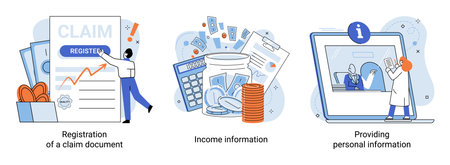Understanding the Modern Retirement Landscape
Retirement planning in America has undergone a major transformation over the past few decades. Gone are the days when most people could rely solely on a company pension or Social Security to cover all their post-work expenses. Today, retirement is less about reaching a fixed age and more about achieving financial freedom through diverse income streams. With the rising cost of living, fluctuating markets, and longer life expectancies, many Americans are finding that traditional savings strategies just aren’t enough. That’s why a growing number of people are turning to side hustles and gig work as essential parts of their retirement planning toolkit. By supplementing traditional savings with flexible, part-time work—whether it’s driving for a rideshare app, freelancing online, or selling handmade goods—individuals can create extra income, build new skills, and even discover passions that make retirement more fulfilling. This shift reflects not only economic realities but also changing attitudes toward work and financial independence in today’s America.
2. Why Consider Side Hustles for Retirement Planning?
As the cost of living continues to rise and traditional retirement plans like 401(k)s and IRAs face market fluctuations, more Americans are looking for creative ways to bolster their financial future. Incorporating side hustles and gig work into your retirement planning isn’t just about earning extra cash—it’s about creating a safety net that brings both security and flexibility. By supplementing your main savings with additional income streams, you can reduce the risk of outliving your nest egg and adapt more easily to unexpected expenses or lifestyle changes.
The Benefits of Multiple Income Streams
Diversifying your sources of income has always been a smart move in investing, and the same logic applies to retirement planning. Here’s how adding side gigs can make a difference:
| Benefit | Description |
|---|---|
| Financial Security | Extra earnings can be funneled directly into savings or investments, helping you build a larger cushion for retirement. |
| Flexibility | Side hustles often let you choose your hours and workload, making it easier to balance work with leisure as you approach retirement. |
| Skill Development | Engaging in gig work can keep your skills sharp or help you learn new ones, potentially opening doors to new opportunities even after full-time retirement. |
| Reduced Withdrawal Pressure | Having supplemental income means you may not need to tap into your retirement accounts as early or as heavily, allowing those funds to grow longer. |
Real-World Flexibility Matters
Whether you’re driving for Uber, freelancing online, or running an Etsy shop, today’s gig economy offers a wide range of options suited for different interests and schedules. This flexibility allows you to ease into retirement at your own pace or scale up earnings if your financial situation changes unexpectedly. Plus, having extra money on hand can empower you to travel more, pursue hobbies, or support family members—all without derailing your long-term financial goals.

3. Popular Side Hustles and Gig Work Options
With the rise of the gig economy, there are more ways than ever to supplement your retirement savings or generate extra income in retirement. Choosing a side hustle that fits your skill set, schedule, and financial goals is key. Below, we’ll break down some of the most accessible and in-demand options for Americans at different life stages.
Gig Jobs for Every Lifestyle
Platforms like Uber, Lyft, DoorDash, and Instacart have made it simple to start driving or delivering on your own terms. These jobs offer flexibility—perfect if you want to work a few hours a week or scale up when you need extra cash. For those who prefer working from home, companies like Amazon Mechanical Turk or user-testing sites allow you to complete tasks online and get paid per project.
Freelancing Opportunities
If you have specialized skills in writing, graphic design, web development, accounting, or marketing, freelancing might be an ideal fit. Websites such as Upwork, Fiverr, and Freelancer connect you with clients worldwide seeking short- or long-term help. This route can be especially lucrative for retirees with decades of professional experience.
Side Hustles for Different Skill Sets
- Creative Talents: Sell handmade goods on Etsy, photography on Shutterstock, or self-published books on Amazon.
- Teaching & Tutoring: Platforms like VIPKid, Wyzant, and Chegg Tutors let you share your expertise with students online or locally.
- Home & Personal Services: Offer pet sitting via Rover, handyman services through TaskRabbit, or house cleaning using Thumbtack.
Choosing What’s Right for You
Your ideal side hustle should match your interests and lifestyle while providing meaningful income. Whether you’re still in the workforce looking to boost retirement savings or already retired and seeking purposeful activity, the American gig economy offers opportunities for everyone—from tech-savvy millennials to active seniors. Take time to evaluate each option’s earning potential, time commitment, and how well it aligns with your long-term retirement plan.
Managing Taxes and Benefits
When you’re incorporating side hustles and gig work into your retirement planning, understanding how to handle taxes and benefits is crucial. Unlike traditional employment, gig workers are responsible for managing their own self-employment taxes, Social Security contributions, and healthcare coverage. Here’s a practical guide to help you navigate these essential aspects:
Self-Employment Taxes: What You Need to Know
If you earn income from a side hustle or gig job, you’ll need to pay self-employment tax, which covers both Social Security and Medicare contributions. The self-employment tax rate is currently 15.3%. It’s important to set aside a portion of your earnings throughout the year so you’re not caught off guard at tax time.
Quick Guide: Key Tax Responsibilities
| Responsibility | What It Means for Gig Workers |
|---|---|
| Quarterly Estimated Taxes | You may need to pay estimated taxes every quarter if you expect to owe at least $1,000 in taxes for the year. |
| Self-Employment Tax (15.3%) | This covers Social Security (12.4%) and Medicare (2.9%). You can deduct the employer-equivalent portion (half) from your income when calculating your adjusted gross income. |
| Tax Deductions | Keep records of business-related expenses—like mileage, home office costs, and supplies—to reduce taxable income. |
Social Security Considerations for Gig Workers
Your side hustle income counts toward your Social Security earnings record, which can affect your future benefits. Make sure you report all earnings accurately on your tax return. If you consistently contribute through self-employment tax, you can potentially increase your retirement benefit amount. Remember, maximizing your reported income now could mean more financial security later.
Navigating Healthcare Benefits Without Employer Coverage
One of the biggest challenges gig workers face is securing affordable healthcare. Without an employer-sponsored plan, you’ll need to explore options like the Health Insurance Marketplace at Healthcare.gov or consider joining professional associations that offer group health plans. Depending on your income level, you may qualify for subsidies or Medicaid.
Healthcare Options Comparison Table
| Option | Main Features | Best For |
|---|---|---|
| Marketplace Plan (Healthcare.gov) | Various coverage levels; potential subsidies based on income; open enrollment periods apply. | Most independent gig workers seeking comprehensive coverage. |
| Professional Associations/Groups | Group rates; sometimes limited options but better than going solo. | Freelancers or contractors in specific industries or trades. |
| Medicaid/State Programs | No or low cost; eligibility based on state and income level. | Low-income individuals without access to other affordable insurance. |
| Short-Term Health Insurance | Covers emergencies and basic needs; generally lower premiums but limited benefits. | Those between jobs or awaiting other coverage options. |
Action Steps:
- Set aside money regularly for taxes and use IRS Form 1040-ES to estimate quarterly payments.
- Keep meticulous records of all business-related expenses for deductions.
- Report all gig income accurately to maximize future Social Security benefits.
- Research healthcare options annually during open enrollment to ensure continued coverage as your gig work evolves.
Taking these proactive steps will help you avoid surprises and position yourself for a more stable retirement—even when your path isn’t the traditional one!
5. Balancing Work, Lifestyle, and Retirement Goals
Successfully weaving side hustles and gig work into your retirement plan isn’t just about earning extra cash—it’s about making sure these efforts actually improve your quality of life and support your future goals. Achieving this balance requires strategic thinking, self-awareness, and a commitment to protecting your well-being. Here are some actionable strategies for maximizing the benefits of side gigs while steering clear of burnout:
Set Clear Boundaries and Priorities
Start by defining what you want your retirement to look like. Is it about traveling more, spending time with grandkids, or simply having financial security? Once you have a vision, choose side gigs that fit those goals without consuming all your free time. Use tools like digital calendars or time-tracking apps to set strict work hours for your gigs—and stick to them.
Choose Flexible and Enjoyable Gigs
The beauty of the American gig economy is its variety. Pick opportunities that align with your interests or hobbies—like pet sitting through Rover if you love animals, driving for Uber or Lyft if you enjoy socializing, or freelance consulting in your field of expertise. When your gig feels less like a chore, it’s easier to stay motivated and energized.
Pace Yourself and Schedule Downtime
Side hustles can be exciting at first, but overcommitting can quickly drain your energy. Schedule regular breaks throughout your week to recharge and do things that bring you joy outside of work. Remember: the goal is to enhance your lifestyle, not to turn retirement into another full-time job.
Monitor Your Health and Well-being
Pay attention to signs of stress or fatigue. If you start feeling overwhelmed, reassess your workload and consider scaling back. Maintaining a healthy work-life balance is key to ensuring that gig work remains a positive addition to your retirement journey.
Track Financial Progress and Adjust Regularly
Finally, routinely review how your side hustle income is contributing toward your retirement savings. Are you meeting your targets? Do you need to adjust hours or try different gigs? By staying proactive and flexible, you’ll ensure that side hustles continue to support—not sabotage—your long-term retirement goals.
6. Building a Sustainable Future
Incorporating side hustles and gig work into your retirement planning isn’t just about boosting today’s income—it’s about creating a sustainable future. To make your gig income work for you in the long run, focus on smart integration, risk management, and maintaining flexibility as your needs evolve.
Set Clear Financial Goals
Start by defining what you want your retirement to look like and calculate how much you’ll need. Assign a portion of your gig earnings directly to retirement accounts such as IRAs or Roth IRAs. Treat this allocation like a regular bill so that saving becomes automatic and consistent.
Diversify Your Income Streams
Don’t rely on just one side hustle—spread your efforts across different gigs to reduce risk. For example, combine freelance consulting with rideshare driving or online tutoring. Diversification not only provides more security but can also help smooth out fluctuations in income throughout the year.
Integrate Gig Income into Your Investment Strategy
Work with a financial advisor to ensure your gig income is invested wisely. Consider low-cost index funds or target-date retirement funds, which are designed to grow over time while balancing risk. Periodically review your portfolio to ensure it aligns with both market changes and your evolving goals.
Plan for Taxes and Keep Records
Gig workers must manage their own taxes, so set aside a percentage of every payment for federal and state obligations. Use budgeting apps or spreadsheets to track all gig-related income and expenses—this will help at tax time and give you a clearer view of your financial health.
Build an Emergency Fund
The unpredictability of gig work makes an emergency fund essential. Aim to save at least three to six months’ worth of living expenses, so you’re prepared for lean periods or unexpected setbacks without tapping into retirement savings prematurely.
Regularly Reassess Your Plan
Your retirement strategy should evolve along with your career and life changes. Schedule annual reviews of your savings plan, investment allocations, and side hustle performance. By staying proactive, you’ll maximize the benefits of gig work and set yourself up for a financially secure retirement—on your own terms.


